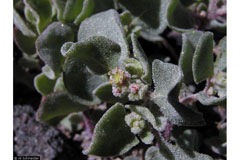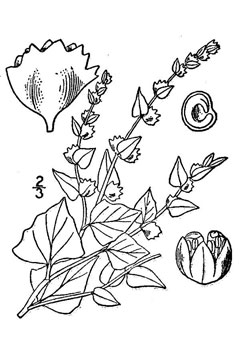 |
|
Al Schneider @ USDA-NRCS PLANTS Database |
 |
| USDA-NRCS PLANTS Database / Britton, N.L., and A. Brown. 1913. An illustrated flora of the northern United States, Canada and the British Possessions. Vol. 2: 18. |
Translate this page:
Summary
Perennial herb of alkaline lowlands across the western U.S. A reliable seed producer and one of the milder “greens” in the genus when cooked.
Physical Characteristics

 Atriplex is a ANNUAL growing to 0.5 m (1ft 8in).
Atriplex is a ANNUAL growing to 0.5 m (1ft 8in).
See above for USDA hardiness. It is hardy to UK zone 5. It is in flower from July to September, and the seeds ripen from August to October. The species is monoecious (individual flowers are either male or female, but both sexes can be found on the same plant) and is pollinated by Wind.
Suitable for: light (sandy) and medium (loamy) soils, prefers well-drained soil and can grow in nutritionally poor soil. Suitable pH: mildly acid, neutral and basic (mildly alkaline) soils and can grow in very alkaline and saline soils.
It cannot grow in the shade. It prefers moist soil and can tolerate drought.
UK Hardiness Map
US Hardiness Map
Synonyms
Plant Habitats
Edible Uses
Leaves (cooked), young fruits, seeds. Edibility rating: 3/5. Taste & processing notes: Pueblo boiled leaves/young fruits alone or with other foods; also used as a salty seasoning. Northern Paiute parched/ground seeds into porridge. Flavor mild for the genus but still saline/“cheno” in tone. Season/harvest: Flowers late summer–early autumn; seeds until cold weather [2-3]. Leaves - cooked, or boiled with other foods as a flavouring[85, 105, 161, 177]. The tender young leaves can be used as greens[216, 257]. Seed - cooked. It can be ground into a meal and used as a thickener in soups etc, or be mixed with flour when making bread etc[85, 257]. The immature seeds can be eaten together with their surrounding calyx[257].
References More on Edible Uses
Medicinal Uses
Plants For A Future can not take any responsibility for any adverse effects from the use of plants. Always seek advice from a professional before using a plant medicinally.
The leaves have been used as a fumigant in the treatment of pain[257]. A poultice of the leaves has been applied to spider bites[257]. A cold infusion of the plant has been used to treat sickness caused by drinking bad water, and to purify the water[257]. A poultice of the chewed roots has been applied to sores and rashes[257]. An infusion of the root has been used in the treatment of stomach aches[257].
References More on Medicinal Uses
The Bookshop: Edible Plant Books
Our Latest books on Perennial Plants For Food Forests and Permaculture Gardens in paperback or digital formats.

Edible Tropical Plants
Food Forest Plants for Hotter Conditions: 250+ Plants For Tropical Food Forests & Permaculture Gardens.
More

Edible Temperate Plants
Plants for Your Food Forest: 500 Plants for Temperate Food Forests & Permaculture Gardens.
More

More Books
PFAF have eight books available in paperback and digital formats. Browse the shop for more information.
Shop Now
Other Uses
A cold infusion of the plant has been used to purify water[257]. Seeds for granivorous birds; foliage browsed by wildlife/livestock in moderation.
Special Uses
References More on Other Uses
Cultivation details
Growing conditions: Full sun; dry to moderately moist, saline/alkaline soils (loams, sandy loams, clay loams); pH neutral–alkaline; high salt tolerance. Hardiness: ~USDA 4–9 (provenance dependent).Habitat & range: Western U.S.; alkaline flats, valley bottoms, disturbed saline ground. Size & habit: Herbaceous perennial, typically 20–70 cm, mealy-silver foliage. Cultivation: Very drought/alkali tolerant; avoid rich, wet soils. Minimal feeding; great for xeriscapes/saline remediation. The following notes are based on the general needs of the genus. Succeeds in full sun in any well-drained but not too fertile soil[200]. Most species in this genus tolerate saline and very alkaline soils[200].
References Carbon Farming Information and Carbon Sequestration Information
Temperature Converter
Type a value in the Celsius field to convert the value to Fahrenheit:
Fahrenheit:
The PFAF Bookshop
Plants For A Future have a number of books available in paperback and digital form. Book titles include Edible Plants, Edible Perennials, Edible Trees,Edible Shrubs, Woodland Gardening, and Temperate Food Forest Plants. Our new book is Food Forest Plants For Hotter Conditions (Tropical and Sub-Tropical).
Shop Now
Plant Propagation
Seed direct-sown in fall or spring after cold-moist strat. Lightly cover; do not overwater. Germination is usually rapid.
Other Names
If available other names are mentioned here
Silverscale (Atriplex argentea)
Native Range
NORTHERN AMERICA: Canada (Saskatchewan (south), Alberta (south), Manitoba (south), British Columbia (south)), United States (Kansas, Nebraska, North Dakota, Oklahoma, South Dakota, Colorado, Idaho, Montana, Oregon, Washington, Wyoming, New Mexico, Texas, Arizona, California, Nevada, Utah), Mexico (Chihuahua)
Weed Potential
Right plant wrong place. We are currently updating this section.
Please note that a plant may be invasive in one area but may not in your area so it's worth checking.
Conservation Status
IUCN Red List of Threatened Plants Status :

| Related Plants
|
| Latin Name | Common Name | Habit | Height | Hardiness | Growth | Soil | Shade | Moisture | Edible | Medicinal | Other |
| Atriplex argentea | Silvery Orach, Silverscale saltbush, Stalked saltbush | Annual | 0.5 |
4-9
| | LM | N | M | 3 | 2 | 2 |
| Atriplex argentea expansa | Silverscale Saltbush | Annual | 0.6 |
-
| | LM | N | M | 2 | 0 | |
| Atriplex californica | California Orach, California saltbush | Perennial | 0.1 |
7-10
| M | LM | N | DM | 3 | 0 | 3 |
| Atriplex canescens | Grey Sage Brush, Fourwing saltbush | Shrub | 1.8 |
3-9
| M | LM | N | DM | 3 | 1 | 3 |
| Atriplex carnosa | Thickleaf Orach | Annual | 0.9 |
-
| | LM | N | DM | 2 | 0 | |
| Atriplex cinerea | Grey Saltbush | Shrub | 2.0 |
9-11
| M | LM | N | DM | 3 | 0 | 3 |
| Atriplex confertifolia | Shadscale, Shadscale saltbush | Shrub | 1.5 |
4-9
| M | LM | N | DM | 3 | 1 | 2 |
| Atriplex coronata | Crownscale | Annual | 0.4 |
-
| | LM | N | DM | 2 | 0 | |
| Atriplex dimorphostegia | | Annual | 0.2 |
-
| | LM | N | DM | 2 | 0 | |
| Atriplex elegans | Wheelscale Saltbush | Annual | 0.2 |
0-0
| | LM | N | DM | 3 | 0 | 1 |
| Atriplex glabriuscula | Scotland orache, Maritime saltbush, Frankton's saltbush, Northeastern saltbush | Annual | 0.3 |
0-0
| | LM | N | DM | 2 | 0 | |
| Atriplex gmelinii | Gmelin's saltbush | Annual | 0.5 |
0-0
| | LM | N | DM | 2 | 0 | |
| Atriplex halimus | Sea Orach, Saltbush | Shrub | 2.0 |
7-10
| M | LM | N | DM | 5 | 1 | 3 |
| Atriplex hastata | Hastate Orach | Annual | 0.8 |
0-0
| | LM | N | DM | 3 | 0 | 2 |
| Atriplex hortensis | Orach, Garden orache | Annual | 1.8 |
5-9
| F | LM | N | M | 4 | 2 | 3 |
| Atriplex lapathifolia | | Annual | 0.9 |
-
| | LM | N | DM | 3 | 0 | |
| Atriplex lentiformis | Quail Bush, Big saltbush, Quailbush, | Shrub | 3.0 |
8-11
| M | LM | N | DM | 2 | 1 | 3 |
| Atriplex littoralis | Grassleaf orache | Biennial | 0.7 |
4-11
| F | LMH | N | DM | 2 | 0 | 0 |
| Atriplex maximowicziana | Maximowicz's saltbush | Perennial | 0.8 |
0-0
| | LM | N | DM | 2 | 0 | |
| Atriplex mucronata | | Annual | 0.4 |
-
| | LMH | N | DM | 2 | 0 | |
| Atriplex nummularia | Giant Saltbush, Bluegreen saltbush | Shrub | 3.5 |
7-10
| M | LM | N | DM | 3 | 2 | 3 |
| Atriplex nuttallii | Nuttall's Saltbush | Shrub | 0.9 |
5-9
| M | LM | N | DM | 4 | 0 | 2 |
| Atriplex obovata | Mound Saltbrush | Shrub | 1.0 |
5-9
| M | LMH | N | DM | 3 | 0 | 3 |
| Atriplex patula | Spreading Orach, Spear saltbush | Annual | 0.8 |
0-0
| | LM | N | M | 3 | 1 | 0 |
| Atriplex polycarpa | Cattle spinach | Shrub | 1.0 |
8-10
| M | LM | N | DM | 1 | 0 | 4 |
| Atriplex powellii | Powell's Saltweed | Annual | 0.7 |
4-9
| | LM | N | DM | 3 | 0 | 2 |
| Atriplex rosea | Tumbling or redscale saltweed | Annual | 0.6 |
3-10
| F | LM | N | DM | 2 | 2 | 2 |
| Atriplex saccaria | Sack Saltbush | Annual | 0.3 |
5-9
| | LM | N | DM | 3 | 0 | 0 |
| Atriplex semibaccata | Australian Saltbush. Australian saltbush, Creeping saltbush | Shrub | 0.5 |
8-11
| F | LMH | N | DM | 3 | 0 | 3 |
| Atriplex serenana | Bractscale, Davidson's bractscale | Annual | 3.0 |
8-11
| | LM | N | DM | 3 | 0 | 0 |
|
|
Growth: S = slow M = medium F = fast. Soil: L = light (sandy) M = medium H = heavy (clay). pH: A = acid N = neutral B = basic (alkaline). Shade: F = full shade S = semi-shade N = no shade. Moisture: D = dry M = Moist We = wet Wa = water.
Now available:
Food Forest Plants for Mediterranean Conditions
350+ Perennial Plants For Mediterranean and Drier Food Forests and Permaculture Gardens.
[Paperback and eBook]
This is the third in Plants For A Future's series of plant guides for food forests tailored to
specific climate zones. Following volumes on temperate and tropical ecosystems, this book focuses
on species suited to Mediterranean conditions—regions with hot, dry summers and cool, wet winters,
often facing the added challenge of climate change.
Read More
Expert comment
Author
Nutt.
Botanical References
43235270
Links / References
For a list of references used on this page please go here
Readers comment
| Add a comment |
|
If you have important information about this plant that may help other users please add a comment or link below. Only comments or links that are felt to be directly relevant to a plant will be included. If you think a comment/link or information contained on this page is inaccurate or misleading we would welcome your feedback at [email protected]. If you have questions about a plant please use the Forum on this website as we do not have the resources to answer questions ourselves.
* Please note: the comments by website users are not necessarily those held by PFAF and may give misleading or inaccurate information.
To leave a comment please Register or login here All comments need to be approved so will not appear immediately.
|
|